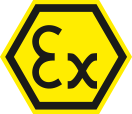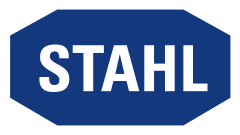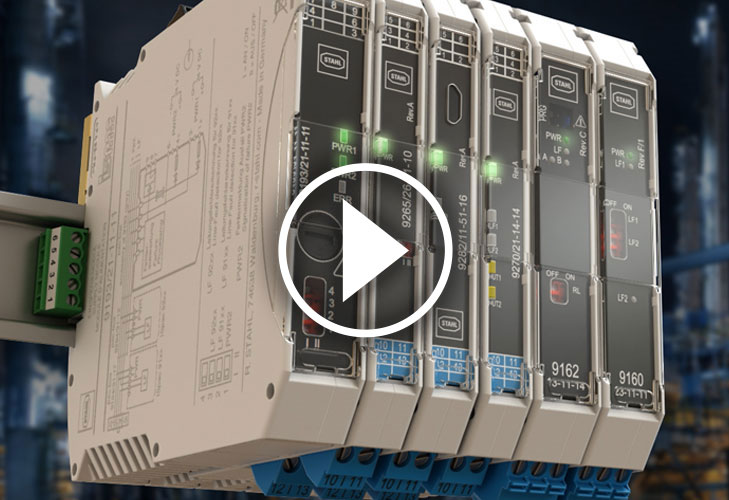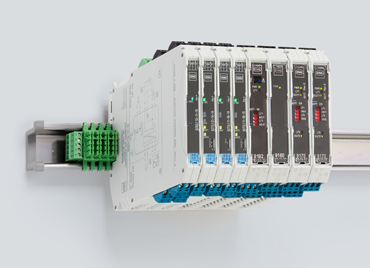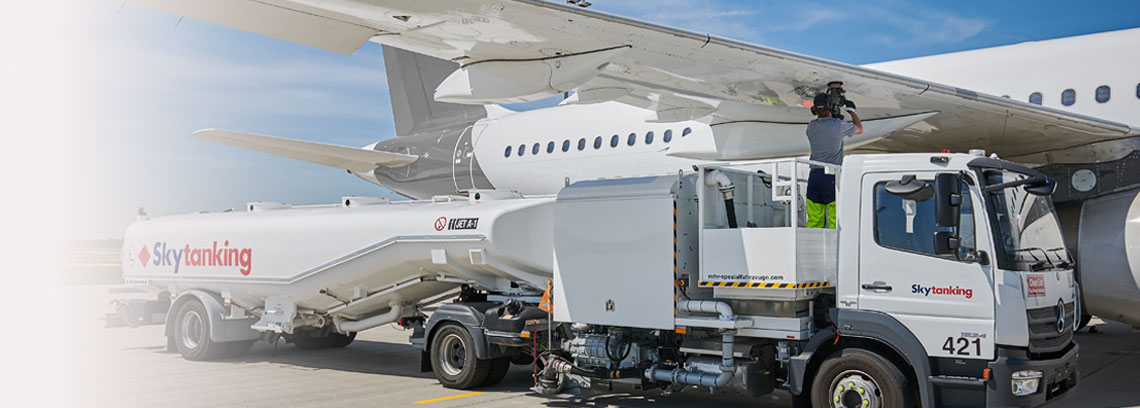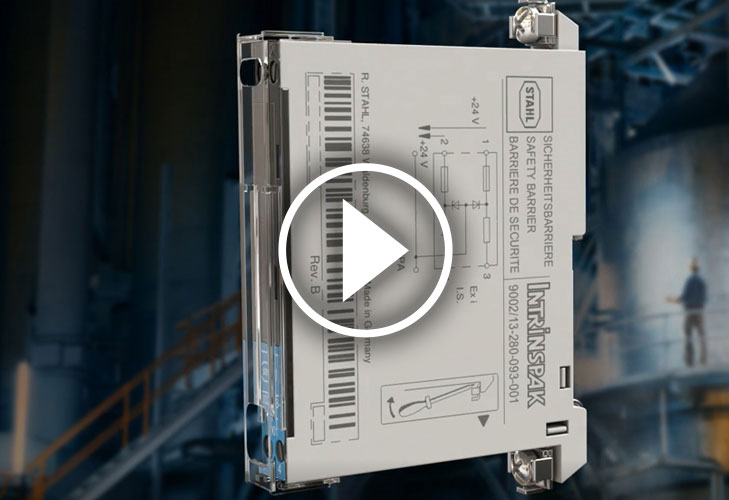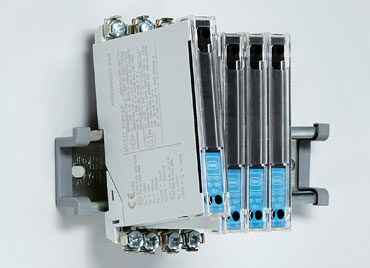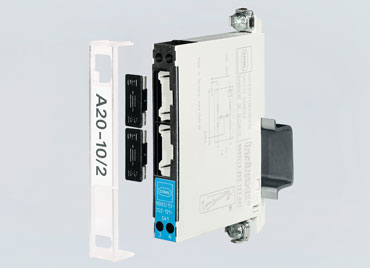Explosion protection thanks to intrinsically safe barriers
In hazardous areas, there are a range of protective measures to prevent the formation and ignition of an explosive atmosphere. The intrinsic safety type of protection plays an important role in process automation. Intrinsic safety requires us to consider the entire electrical circuit, which consists of a current/voltage source, consumers and cables. This means that in order to use intrinsically safe field devices such as sensors, transmitters or valves, intrinsically safe barriers are also always required. These barriers create a failsafe limit for the amount of energy within the electrical circuit so that no ignitable spark or thermal sources of ignition can be created. The intrinsic safety type of protection significantly simplifies the installation, handling and maintenance of field devices, as these activities can be performed during ongoing operation.
The following information will explain more about the functions, applications and advantages of isolators and safety barriers in hazardous areas.
ISOLATORS
The function of an isolator
In process technology-related systems, isolators – also known as isolated barriers – can be used to integrate field devices in automation systems. Point-to-point connections with conventional isolators are a proven and easy-to-use solution. These devices are based on the galvanic separation of intrinsically safe and non-intrinsically safe circuits. This ensures a high degree of safety as there is no conductive connection between the hazardous area and the "normal" world.
A good isolated barrier needs to be multi-talented. It has to provide reliable Ex i isolation, precisely transmit signals and accurately display error messages. They also need to be long-lasting and easy to install. They must therefore be suitable for a number of applications in hazardous areas. R. STAHL's ISpac isolator range is easy to use and boasts an impressive range of functions and a long service life. See for yourself!
Our products and their advantages
Intrinsic safety with single or dual channel safety barriers. These safety barriers from R. STAHL enable you to operate HART transmitters, potential-free contacts, temperature sensors, solenoid valves, indicators and much more equipment in an intrinsically safe manner. What's more, R. STAHL safety barriers are approved for global use and are certified for UL, EAC, KGS, IECEx, ATEX and much more.
R. STAHL's 9004 series INTRINSPAK safety barriers are ideally suited to supplying field devices with intrinsically safe auxiliary power due to their electronic current limiting. Zener barriers are available for all application areas in automation technology and for all signal types, such as transmitters, control valves, solenoid valves, LED indicator lamps, vibration sensors and resistance temperature detectors.
Download our extensive product data sheet for all application areas. Or contact us directly. We are always happy to provide expert, professional advice from experienced specialists. We can also help you to choose from the range of suitable barriers or to assess simple electrical equipment.
Analog input
| Function | Channels | 17.6 mm | 12.5 mm | Highlights | ||
|---|---|---|---|---|---|---|
Isolating amplifier | 1 |
| x |
| ||
1 in / 2 out |
| x | ||||
Transmitter supply | 1 | x | x | |||
2 | x | x | ||||
1 in / 2 out | x | x | ||||
Transmitter supply | 1 | x |
|
| ||
Analog output
| Function | Channels | 17.6 mm | 12.5 mm | Highlights | ||
|---|---|---|---|---|---|---|
24 V DC supply, | 1 | x | x |
| ||
| 2 | x | x | ||||
Loop powered | 2 | x |
| |||
Digital input
| Function | Channels | 17.6 mm | 12.5 mm | Highlights | ||
|---|---|---|---|---|---|---|
Switching repeater with relay | 1 | x | x |
| ||
| 2 | x | x | ||||
Switching repeater with relay | 1 | x | ||||
| 2 | x | |||||
Switching repeater with | 1 | x | x | |||
| 2 | x | x | ||||
Digital output
| Function | Channels | 17.6 mm | 12.5 mm | Highlights | ||
|---|---|---|---|---|---|---|
24 V DC supply, | 1 | x | x |
| ||
| 2 | x | |||||
Loop powered | 1 | x | x | |||
| 2 | x | |||||
Relay module | 2 | x |
| |||
Temperature input
| Function | Channels | 17.6 mm | 12.5 mm | Highlights | ||
|---|---|---|---|---|---|---|
Temperature transmitters | 1 | x | x |
| ||
| 2 | x | |||||
Temperature transmitters | 1 | x | ||||
| 2 | x | |||||
Resistance isolator | 1 | x |
| |||
| 2 | x | |||||
Vibration / Acceleration
| Function | Channels | 17.6 mm | 12.5 mm | Highlights | ||
|---|---|---|---|---|---|---|
Vibration transducer, | 1 | x |
| |||
| 2 | x | |||||
Serial communication
| Function | Channels | 35.2 mm | Highlights | ||
|---|---|---|---|---|---|
RS-485, RS-422 Ex i / | 1 | x |
| ||
SAFETY BARRIERS
The function of a safety barrier
Safety barriers, also known as Zener barriers, connect intrinsically safe circuits to non-intrinsically safe circuits such as Ex i field devices and control technology. A suitable barrier will always be found – an individual barrier or a combination of barriers – for standard signals such as 4 to 20 mA and for less common signals.
The barriers use a combination of Zener diodes, resistors and fuses to limit the electrical energy that enters the hazardous area. This means that there is no risk of ignition due to sparks or thermal effects. The cost-effective safety barriers protect the electrical circuits (cables and equipment) that are installed in hazardous areas. Unlike with isolators, however, this does not involve galvanic separation between the intrinsically safe and non-intrinsically safe circuit. A wide range of sensors is used for the automation of machines. In doing so, there are many things to consider. Every device requires the appropriate solution for Ex i protection. INTRINSPAK covers this spectrum with a range of more than 70 variants – with a footprint of just 12 mm.
As one of the pioneers in the safety barrier sector, R. STAHL places great importance on easy installation and maintenance. Installation is also incredibly simple. All you need to do is snap the barrier onto the DIN rail – this action also equalises the potential between the conductive parts. What's more, only one PA collective connection is required for each rail. An easily interchangeable back-up fuse protects the internal fuse and the barrier itself, thereby simplifying storage and maintenance. Details such as the combination of assembly and equipotential bonding connection or a uniform, exchangeable backup fuse make INTRINSPAK unique. See for yourself!
Our products and their advantages
Intrinsic safety with single or dual channel safety barriers. These safety barriers from R. STAHL enable you to operate HART transmitters, potential-free contacts, temperature sensors, solenoid valves, indicators and much more equipment in an intrinsically safe manner. What's more, R. STAHL safety barriers are approved for global use and are certified for UL, EAC, KGS, IECEx, ATEX and much more.
R. STAHL's 9004 series INTRINSPAK safety barriers are ideally suited to supplying field devices with intrinsically safe auxiliary power due to their electronic current limiting. Zener barriers are available for all application areas in automation technology and for all signal types, such as transmitters, control valves, solenoid valves, LED indicator lamps, vibration sensors and resistance temperature detectors.
Download our extensive product data sheet for all application areas. Or contact us directly. We are always happy to provide expert, professional advice from experienced specialists. We can also help you to choose from the range of suitable barriers or to assess simple electrical equipment.

